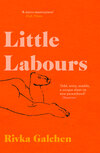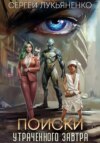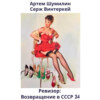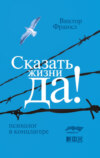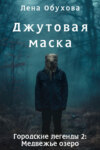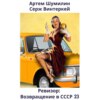Читать книгу: «Little Labours»

Copyright
4th Estate
An imprint of HarperCollinsPublishers
1 London Bridge Street
London SE1 9GF
This eBook first published in Great Britain by 4th Estate in 2017
First published in the United States by New Directions in 2016
Copyright © Rivka Galchen 2016
Design by Erik Rieselbach
Cover design by Anna Morrison
Rivka Galchen asserts the moral right to be identified as the author of this work
“Notes on Some Twentieth-Century Writers” originally appeared in Harper’s Magazine.
A catalogue record for this book is available from the British Library
All rights reserved under International and Pan-American Copyright Conventions. By payment of the required fees, you have been granted the non-exclusive, non-transferable right to access and read the text of this e-book on-screen. No part of this text may be reproduced, transmitted, down-loaded, decompiled, reverse engineered, or stored in or introduced into any information storage and retrieval system, in any form or by any means, whether electronic or mechanical, now known or hereinafter invented, without the express written permission of HarperCollins
Source ISBN: 9780008225186
Ebook Edition © October 2016 ISBN: 9780008225193
Version: 2019-02-04
Contents
Cover
Title Page
Copyright
Children’s books
The crystal child
A long, long time ago, in late August
A reason to apologize to friends
What drug is a baby?
Dynasty
Cargo cult
Mysteries of taste
Cravings
Religious aspects of the baby
Head shape
The romantic comedy
Wiped out
The species
Literature has more dogs than babies
More Frankenstein
And movies
Princess Kaguya
Rumpelstiltskin
How the puma affects others, one
How the puma affects others, two
Notes on some twentieth-century writers
Other people’s babies
Other people’s babies, two
Other people’s babies, three
Other people’s babies, four
Reversals
Mother writers
When the baby came home
When the empress moved
Screens
iPhone footage
Lots of writers have children
In Flagstaff, one
In Flagstaff, two
New variety of depression
A baby is an ideal vector for a revenge plot
A modern anxiety
Things that one was misleadingly told were a big part of having a baby
Babies in art
Video games
Orange
More babies in art
Sometimes it can seem like many hours with a baby
Stranger danger
How the puma affects others, three
Most of the great women writers of the twentieth century
Women writers
Baby girls and men
A friend who is not a close friend
I never
A Doll’s House
People who get along well with babies
The beginning of misunderstanding
A new citizen
Money and babies
Keep Reading …
About the Publisher
Children’s books
Books for young children rarely feature children. They feature animals, or monsters, or, occasionally, children behaving like animals or monsters. Books for adults almost invariably feature adults.
The crystal child
My mother tells me that people tell her, when she is out with the baby, that the baby is a crystal child. Some people ask for permission to touch the baby, because contact with crystal children is healing. “You should research what it is, crystal children,” my mother, who has a master’s degree in computer science and an undergraduate degree in mathematics, says more than once. From the moment my mother first met the baby, she found her to be an exceptional and superior creature; her ascribing of crystal child qualities to the baby is part of this ongoing story.
I finally go ahead and research crystal children. On the Web. I learn that, unlike rainbow children, crystal children have a difficult time because they believe they can change the way people think in order to heal the world; rainbow children by contrast understand that people cannot be changed, they can only be loved as they are; rainbow children are therefore less frustrated than crystal children. Crystal children were born, one site explains, mostly in the nineties, whereas rainbow children arrived, by and large, in the new millennium—prior to the generation of crystal children there was a generation of indigo children—and so maybe the puma is in fact a rainbow child, rather than a crystal child, or maybe she is part of an even newer generation, as yet uneponymized.
Maybe in the same way that children in the Middle Ages who were born with congenital hypothyroidism (as was common before salt was iodized because iodine is essential to thyroid development) had a certain look, and were mentally different from the mainstream, and were referred to as chrétiens—a term which unfortunately over time became cretins though all it meant at the time was Christians—crystal and rainbow and indigo children are terms used mostly if not prescriptively to refer to children who are unusual in ways most commonly associated with autism or Down’s syndrome.
Somehow I begin to believe in crystal children, and in the idea that my child has the special healing powers ascribed to crystal children. I start to believe this even though, unlike my mother, I don’t have a master’s degree in computer science, or an undergraduate degree in math. When I read one day that Isidor of Seville, back in the seventh century, was already saying that the world was round, he somehow knew so intuitively, I decide this is relevant.
But I still don’t understand why no one has ever stopped me on the street to talk about crystal children, why they have only stopped my mother. And I don’t understand why my mother, usually so suspicious of any comments made by “others,” is so open to these comments. Someone important to me says, “It sounds like a way to love and value children who are difficult.” Sure, I say, that sounds true. “Maybe your mother is telling you that she is a crystal child. Or that you are.”
A long, long time ago, in late August
In late August a baby was born, or, as it seemed to me, a puma moved into my apartment, a near-mute force, and then I noticed it was December, and a movie was coming out on what is sometimes called the day of the birth of our savior. If one was to accord respect to the tetraptych poster campaign, Forty-Seven Ronin featured one Keanu Reeves, one robot, one monster, and one young woman dressed in green and, for unclear reasons, upside-down. The poster I kept seeing was at the end of my block, below a dance studio, around the corner from a deli next door to a Japanese clothing shop that specializes in looks inspired by American streetwear, and across the street from a dollar-a-slice pizza place perennially playing Mexican pop music. I had melatonic madness at the time. Maybe for that reason the poster, as I passed it four or five times a day, always with the puma, began to seem to really mean something, something more than what was manifest. I felt this even though I knew the poster would soon enough be replaced by one for Vampire Academy or the newest remake of Robocop, and in fact it felt almost as if that randomness-revealing replacement had already happened, as if that was part of the poster’s message, that the accumulation of tomorrows was not—however lost to time I might be—going to cease producing its predictable melancholy. (However I, and I registered this as rare, I was myself at the time not melancholic. Not at all.) But the paradox was that as my life had become a day of unprecedented length, a day that I was calculating to now be almost three thousand hours long (in doing the math I realized that since the puma’s arrival I had not slept more than 2½ hours in a row) my thoughts had become unprecedentedly interrupted, as if every three minutes I had fallen asleep, curtailing any thought, morphing it into dream, which, when I woke, was lost altogether. What I mean to say is that I wasn’t working. This even though my plan had been to work. And to think. Even after the baby was born. I had imagined that I was going to meet, at birth, a very sophisticated form of plant life, a form that I would daily deliver to an offsite greenhouse; I would look forward to getting to know the life-form properly later, when she had moved into a sentient kingdom, maybe around age three. But instead, within hours of being born, the being—perhaps through chemicals the emotional-vision equivalent of smoke machines—appeared to me not like a plant at all, but instead like something much more powerfully moving than just another human being, she had appeared as an animal, a previously undiscovered old-world monkey, but one with whom I could communicate deeply: it was an unsettling, intoxicating, against-nature feeling. A feeling that felt like black magic. We were almost never apart.
I felt suddenly older, even as the puma also, in her effect on me, made me more like a very young human in one particular way, which was that all the banal (or not) objects and experiences around me were reenchanted. The world seemed ludicrously, suspiciously, adverbially sodden with meaning. Which is to say that the puma made me again more like a writer (or at least a certain kind of writer) precisely as she was making me into someone who was, enduringly, not writing.
And I really wanted to see the new forty-seven ronin movie. Even though I had no time for movies. And even though I knew there was an old version of the movie—maybe more than one old version—to which more than one person in my life had been devoted, and I always feel, and felt then, as most people do, some vague obligation to be faithful to the old, and disdainful toward the new, just as a general rule, a general rule to which I’m not deeply (or generally) opposed, even though it is stupid. But any disdain toward the new forty-seven ronin would have been superfluous anyway, since I can now tell you from this distance in time and space, that the movie that I was so ready to find meaningful was out of theaters before I ever got to see it, that it failed unambiguously in the United States and ignominiously in Japan where, despite its budget of $175 million and its popular Japanese cast and its wide release in 693 theaters—I was researching—and even its additional last-minute 3D effects and furthermore despite the fact that the base story was one which its native audience has been interested in hearing told again and again for nearly two centuries now—in Japan, the story of the forty-seven ronin is such a seminal one that there’s even a special term, chushingura, just to describe its tellings—the movie’s box office return in Japan substantially trailed that of its competitors, Lupin the 3rd vs Detective Conan and The Tale of Princess Kaguya: A Princess “Crime and Punishment.”
But the poster had done its unplanned labor. A story of valiance and violence had reseeded itself into my mind and perhaps the minds of countless hungry people who had treated themselves to a slice of dollar pizza, gaze drifted to the new ronin advertised across the street.
What is a ronin? A ronin is an unemployed samurai. Or a samurai without a master. A sword for hire. The term in its time had about it something of menace or disgrace. That is no longer the case. The story of the forty-seven ronin, a few centuries old and based on a historic event and told and retold in plays and movies and honorary temple garden plaques has changed all that. The original forty-seven men (some scholars say maybe there were only forty-six) served a master who was murdered, in court, over a matter of etiquette. The murdered man’s forty-seven (or forty-six) samurai were expected to avenge their master. But months passed, nothing happened. The samurai, now ronin, were said to have returned to domestic lives, or turned to drinking, or to both; it was considered shameful. But because the ronin are leading shamefully ordinary lives, the murderer of their master relaxes his guard; it appears there will be no revenge. But there will be. The ronin covertly gather, storm the compound of their master’s enemy, and present his severed head to the palace. The forty-seven (or forty-six) ronin then commit self-sentenced sepukku—they are murderers now, after all—which is how their own master was coerced into ending his life as well: a symmetry. All of this is understood to be heroic (as opposed to horrifying). Honor reveals itself. In a certain way samurai resembled the wives in those cultures where the widowed are expected to throw themselves on the funeral pyre.
The story of the ronin was especially popular in the Meiji era, when Japan’s isolation policy ended and power shifted from the military back to the emperor; the story was then again even more popular in the years after World War II, or so I’m told. The postwar government coerced the great filmmaker Mizoguchi, who usually made films about women in difficult circumstances, into making a movie of the forty-seven ronin, and the film’s part one failed terribly, but Mizoguchi himself then wanted to make part two and did. What made the story of the forty-seven ronin so popular at those particular moments? What is the story of the forty-seven really about? A story of men who appear to be defeated and shameful, but who have elected that appearance as an essential guise for a noble plan which will become manifest? A story of violence, patience, and outsized fidelity to the master who randomly is yours?
This story is about a baby, I thought of the bloody boyish tale one afternoon, I’m not sure which afternoon, just a bright one, passing the poster with the upside-down woman as I rounded the corner past the deli. Everything was about a baby, then, but still I thought, with conviction: a baby is what the story of the forty-seven ronin is really about. The sleeper cell, the latent power—it’s a parable about babies. They appear helpless, but they are puppetmasters. It makes so much sense. I was obviously wrong, more or less. I had been wanting, at the time of the forty-seven ronin haunting, to think on paper about, not quite coincidentally, two Japanese books: The Pillow Book by Sei Shonagon and The Tale of Genji by Murasaki Shikibu. They were two of my favorite books. It seemed mysterious to me that they both came from the same place and time, from the imperial court of early eleventh-century Japan. Both books were by women which also, I hated to admit, mattered to me. But I wasn’t managing to think about either book. The puma insisted otherwise. But I didn’t want to write about the puma. Mostly because I had never been interested in babies, or in mothers; in fact those subjects had seemed perfectly not interesting; maybe I was even repelled by mothers and babies as subjects to write about; and so, after I had the baby, I found myself in the position (now interested in babies) of those political figures who come to insights others had reached decades ago only after their personal lives intersected with an “issue,” like, say, Dick Cheney, with his daughter, who married a woman. But I still didn’t want to write about babies, albeit now for a different reason. I had originally wanted to write about other things because I was interested in those other things. I then specifically wanted to write about other things because that then might mean I was really, covertly, learning something about the baby, or about babies, or about being near babies, and these were subjects about which, directly, I had so little to say. In the end, without consulting me much, a cabal of neuronal circuits, ronin of their own kind, organized against me and went about coordinating their own thoughts, fueled by dollar pizza, in a minor court on 38th Street.
Бесплатный фрагмент закончился.


